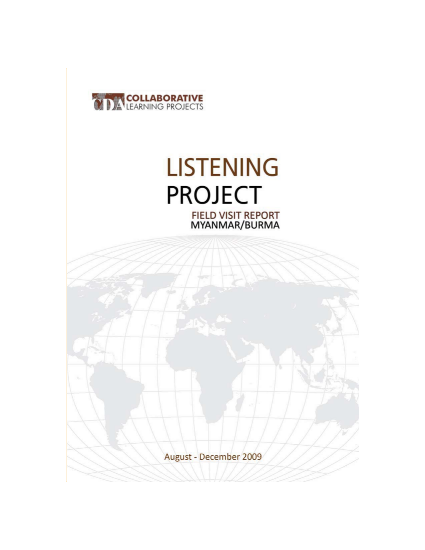
The Nyein/Shalom Foundation of Myanmar and the Center for Peace and Conflict Studies in Cambodia CPSC, organized the Listening Exercise with CDA in two phases, in August/September and in December 2009.
In the first phase, there were 17 Listening Team members with 2 facilitators provided by CDA and CPCS, while in the second phase there were 13 Listening Team members and 1 facilitator. Most of the team members were nationals of Myanmar/Burma, many of them staff of partner organizations of the Nyein Foundation. Some were staff members of local NGOs, churches, or other organizations, and 2 were Cambodian. The facilitators were Cambodian and American. Listening Teams listened to a wide variety of people, ranging from local authorities, Christian and Buddhist priests, villagers/farmers, and NGO staff. Most people expressed some knowledge about aid efforts or international assistance in their area, except for some people in central Myanmar who were unfamiliar with international aid or assistance. Among people who were aware of international aid, a large number of them were recipients of these assistance efforts. In some places people receive assistance directly, but most assistance was provided through NGOs and INGOs’ development projects. Listening Teams were flexible on how and where conversations were held and they talked with both individuals and with people in groups. Government regulations restricted group size to a maximum of ten people; nonetheless people were willing to talk to the Listening Teams and they managed to listen to people in groups more than in individual conversations. Myanmar/Burma is divided into 14 administrative subdivisions,2 which include 7 states (pyi-ne) and 7 divisions (tyne). The names of divisions (except for Ayeyarwady Division and Tanintharyi Division) are also the names of the capital cities. In addition, divisions are Barma-dominant, while states are ethnic minority-dominant. Given the situation in the country, the decision was taken to prioritize reaching the widest range of ethnic groups.
Following the field visits, the Listening Teams came together and shared what people said in the different locations, drew out common themes, patterns, and divergences, and engaged in preliminary analysis of the evidence. Final analysis and report-writing rested primarily with the lead co-facilitators and the lead organizations, with input from the team members.